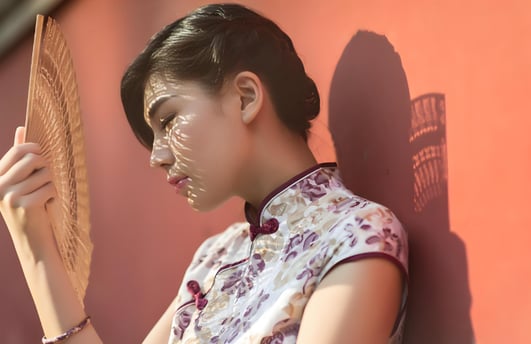The Symbolism of Qipao: A Cultural Tapestry Woven Through Time
The qipao, a quintessential Chinese women's garment, is a rich tapestry of cultural, aesthetic, and societal meanings. It embodies Oriental aesthetics through philosophical elements like high collars and frog fasteners, and symbolic patterns such as floral and geometric motifs.
QIPAO HISTORY
6/23/20252 min read


Cultural Iconography: Embodiment of Oriental Aesthetics
Philosophical Resonance of "Harmony Between Heaven and Humanity"
High collar & frog fasteners: The rigid collar, hugging the neckline, reflects Confucian ideals of modesty, while the intricate knots of frog fasteners symbolize enduring vitality—a metaphor for life’s interconnectedness.
Side slits: Originating from the practical needs of Manchu horseback riding, the slit evolved into an aesthetic device embodying Oriental subtlety—a stark contrast to Western overt sensuality.
Metaphors in Patterns and Motifs
Floral designs: Peonies signify prosperity, plum blossoms resilience, and lotuses purity, turning garments into “poetry worn on the body.”
Geometric motifs: Swastikas and meanders convey wishes for eternity, materializing folk beliefs into fabric.
Aesthetic Revolution: From Constraint to Emancipation
The Battle for Bodily Autonomy
Transitioning from the voluminous changpao of the Qing dynasty, which obscured female forms, the 1920s qipao embraced darts and waistlines to accentuate curves—a visual manifesto of women’s liberation. As Eileen Chang noted in Notes on Clothing, “Fashion is a microcosm of politics,” with the qipao’s silhouette mirroring women’s shift from objects to subjects.
Color Psychology in Era-Defining Styles
1930s Shanghai-style qipao: Bold crimson on black with rolled edges epitomized the independence of urban women.
1950s revolutionary qipao: Cold hues like indigo and olive, paired with minimalist cuts, reflected collectivist ideals.
Societal Mirror: The Qipao as a Canvas of National Identity
Constructing Cultural Identity
In 1929, the Nationalist government designated the qipao as the “national dress,” leveraging it at world expos and through film icons like Ruan Lingyu to project a modern Chinese image.
At the 2014 APEC summit, spouses of world leaders donned tailored qipao, underscoring China’s cultural soft power.
Gender Politics in Threads
Republican era: Hemlines rising from floor-length to ankles, and sleeves shrinking from billowing to sleeveless, chronicled women’s migration from domestic to public spheres.
Contemporary reinterpretations: Designers like Guo Pei fuse qipao with metal embroidery, probing tensions between tradition and technology, fragility and power.
Modern Reimaginings: Tradition Meets Innovation
Deconstructivist Experiments
Ma Ke’s Wu Yong (“Useless”) collection marries qipao with coarse linen, employing “wabi-sabi” aesthetics to critique idealized notions of Oriental femininity.
Xiong Ying’s Gaia Legend blends Suzhou embroidery with 3D printing, giving ancestral motifs a futuristic twist.
Exploring Gender Fluidity
At 2023 Paris Fashion Week, a gender-neutral qipao collection debuted, its loose silhouettes challenging binary norms and echoing LGBTQ+ discourse.
The qipao’s symbolism is inherently fluid—a silent narrator of epochal shifts. It is both the veiled longing of Su Lizhen in In the Mood for Love and the defiant elegance of Yu Mo in The Flowers of War. From diplomatic soirées to avant-garde runways, the qipao remains a mirror reflecting evolving dialogues on cultural identity and female agency. Its enduring power lies in this very adaptability: a dialogue between heritage and innovation, restraint and rebellion.
The qipao, a cornerstone of modern Chinese women’s attire, embodies layers of meaning that evolve with history, blending traditional aesthetics, social transformation, and feminist consciousness. Below, we unpack its symbolism through cultural, aesthetic, and sociological lenses.


